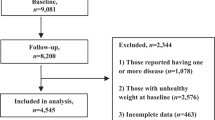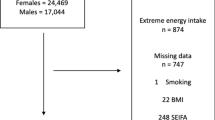Abstract
Objectives: Using a national representative sample to examine variation in fruit and vegetable consumption among adults in the UK, with particular reference to consumers with high and low reported intakes.
Design: National representative dietary survey using 7-d weighed diet records of men and women aged 16–64 y living in private households in the UK in 1986–1987.
Setting: The UK.
Subjects: 1087 men and 1110 women. The sample was selected by a multi-stage random probability design. The response was 70%. Subjects with low energy intake were subsequently excluded.
Main outcome measures: Food group, nutrient intake, physiological measures socio-economic, demographic and behavioural characterstics.
Results: Consumption of fruit and vegetables was estimated. The sample was divided by sex into four quarter groups according to fruit and vegetable consumption. There were significant similarities between quarter groups in fruit and vegetable and other food intake, nutrient intake, physiological measures, and socia-economic, demographic and behavioural variable. The lowest consumers of fruit and vegetables had a mean intake of 738 g/week (men) and 630 g/week (women), equivalent to 1.3 and 1.1 portion/d, respectively. Conversely, the mean intake of both men women with the highest consumption was 3137 g/week (5.6 portions day). There were more than twice as many adults in the age group 16–24 located in Q1 than in Q4. The Manual social class and those in receipt of benefits were negatively associated with fruit and vegetable consumption. Smokers were significantly associated with low fruit and vegetable intake. Being married was associated with increased fruit and vegetable intake and being single or divorced/separated was associated with low fruit and vegetable intake. Eating home grown produce was associated with hogh intake. Consumers who lived in London or the South-East were associated with higher fruit and vegetable intake.
Conclusions: The analysis draws attention to the wide variation in reported fruit and vegetable consumption among British adults. High consumers merit further investigation to elucidate practical strategies for increasing fruit and vegetable consumption. Strategies to increase consumption should be targeted at groups most likely to include low consumers of fruits and vegetables.
Sponsorship: London School of Hygience and Tropical Medicine.
This is a preview of subscription content, access via your institution
Access options
Subscribe to this journal
Receive 12 print issues and online access
$259.00 per year
only $21.58 per issue
Buy this article
- Purchase on Springer Link
- Instant access to full article PDF
Prices may be subject to local taxes which are calculated during checkout
Similar content being viewed by others
Author information
Authors and Affiliations
Contributions
Guarantor: JA Pryer.
Contributors: HB analysised the data and wrote the first draft; JAP supervised HB and edited the paper; RN provided statistical advice and also read and commented on the statistical tests in this paper.
Rights and permissions
About this article
Cite this article
Billson, H., Pryer, J. & Nichols, R. Variation in fruit and vegetable consumption among adults in Britain. An analysis from the dietary and nutritional survey of British adults. Eur J Clin Nutr 53, 946–952 (1999). https://doi.org/10.1038/sj.ejcn.1600877
Received:
Revised:
Accepted:
Published:
Issue Date:
DOI: https://doi.org/10.1038/sj.ejcn.1600877
Keywords
This article is cited by
-
Dietary changes and food habits: social and clinical determinants in a cohort of women diagnosed with breast cancer in Barcelona (DAMA cohort)
Cancer Causes & Control (2021)
-
A comparison of the dietary patterns derived by principal component analysis and cluster analysis in older Australians
International Journal of Behavioral Nutrition and Physical Activity (2016)
-
The distributional and nutritional impacts and mitigation potential of emission-based food taxes in the UK
Climatic Change (2016)
-
Demographics, health-related behaviors, eating habits and knowledge associated with vegetable intake in Japanese adults
European Journal of Clinical Nutrition (2009)
-
The effect of clinical characteristics and dietary habits on the relationship between education status and 5-year incidence of cardiovascular disease: the ATTICA study
European Journal of Nutrition (2008)



